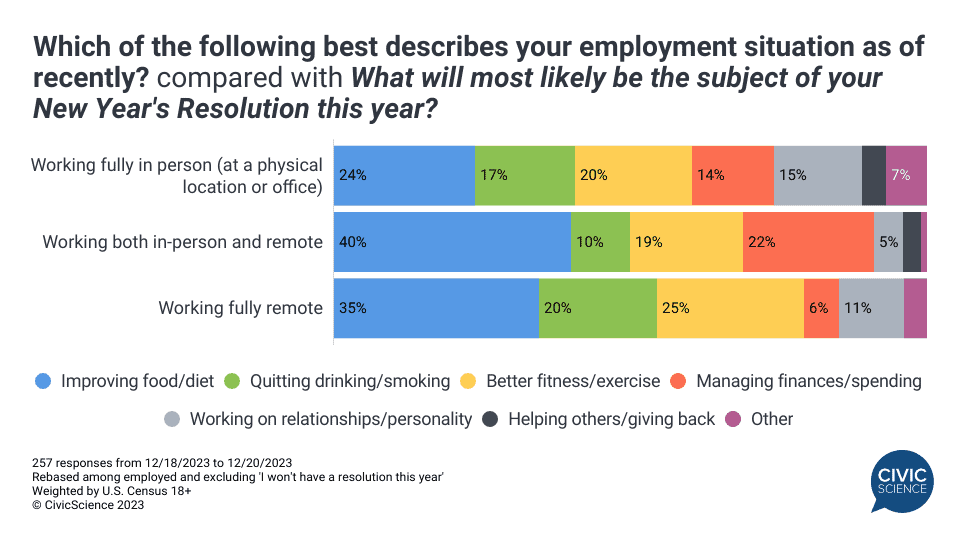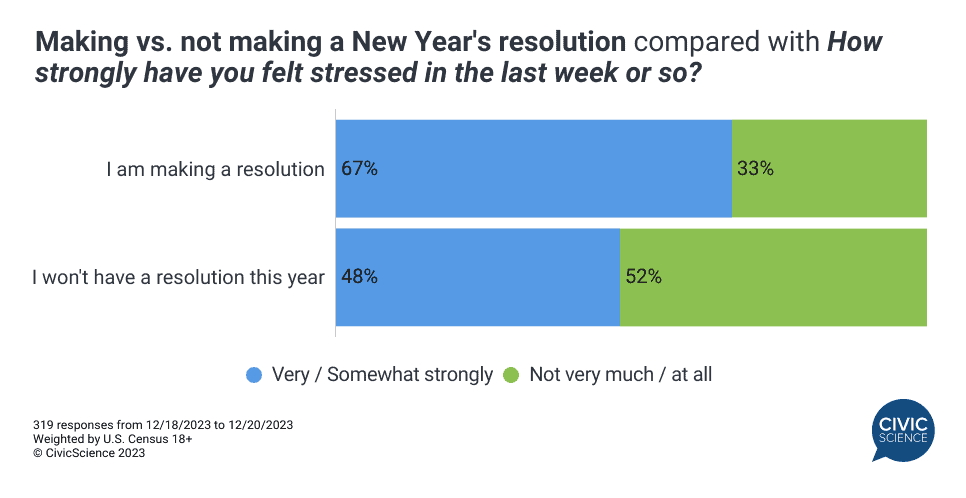With 2024 just a few days away and the scent of a new year filling the air, New Year’s resolutions are on everyone’s mind. Which categories are captivating this year’s resolution-makers, and what can they tell us about spending trends in the new year? Current CivicScience data gives us the inside scoop.
Statistically speaking, 58% of U.S. adults will be making a resolution this year. Although that number is down three percentage points from last year, resolution-makers are still in the majority.
If you’ve been following New Year’s resolution trends, it will come as no surprise that improving food and diet remains the top priority, with 31% of Americans stating that as their goal for 2024 (among those making resolutions). This is up four percentage points from last year. A focus on better fitness and exercise is second (down four percentage points), while managing finances is third (up one percentage point).

It’s also worth noting that working on relationships has jumped three percentage points since last year’s report, as Americans are still struggling with the lingering social impacts of the pandemic. So while the usual contender is coming out on top, the runners-up do show some shift in priorities as we transition into the year ahead.
Take Our Poll: Is your New Year’s Resolution the same as it was last year?
Resolution-Makers in 2024
According to this year’s data, adults aged 18-34 and consumers who work hybrid jobs (both in-person and remote) are among those most likely to resolve to change their lives in the new year – around three-fourths are making New Year’s resolutions.
In particular, work environment may play more of a role than you’d think, with those who work fully in-person jobs ranking as least likely to have a resolution. However, if they are making a resolution, in-person employees are far more likely than others to prioritize relationships. Hybrid workers are the most likely to want to improve food/diet, while fully remote workers are focused more on fitness than others.

Rounding out the data, men are more likely than women to prioritize food and diet resolutions, as well as fitness and exercise, whereas women are more likely to prioritize managing finances/spending. And while young adults are also highly focused on food/diet, Gen Z (18-24) is the age group most interested in fitness, while young Millennials (25-34) show the strongest interest in better managing their finances.
The Stress Effect
It goes without saying that every individual comes to their resolution for different reasons. But, are there any overall themes and trends to note? Of course, the answer is yes. More than two-thirds of those who are making a resolution report they’ve been feeling stressed recently – 19 points higher than those not making resolutions – but the majority of resolution-makers are also doing ‘better’ or ‘the same’ financially than they were before the COVID-19 pandemic. That suggests that while their lives may not currently be peaceful, they may have the resources to invest in finding a solution.

So while New Year’s resolution making continues to carry its health and wellness sheen, beneath the surface, resolution-makers are beginning to find more nuance-shifting priorities toward relationships, financial management, and deeper pursuit of what it means to be well in the new year.
Answer Our Poll: How many times in your life have you achieved a New Year’s resolution?
For even deeper consumer insights looking ahead into 2024 and beyond, get in touch.








